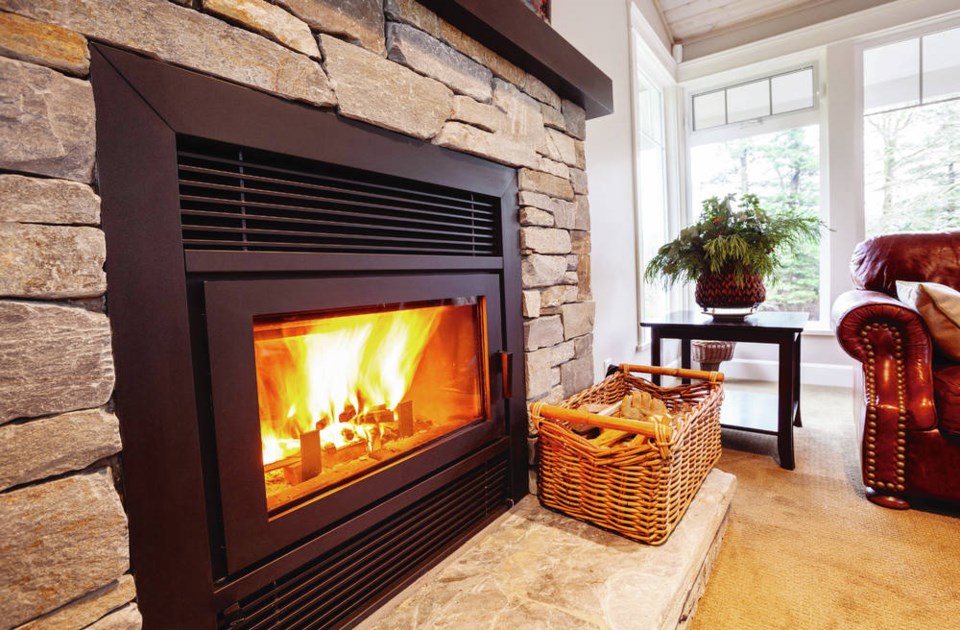Never mind that heating with wood is one of the least efficient sources of energy, there’s something primal and comforting about the sound, sight and smell of a wood fire cracking in a fireplace or stove.
But the neighbours might be less impressed, and indeed, keeping the home fires burning in some sa���ʴ�ý communities is becoming more and more difficult.
Residential wood burning is one of the main human-caused sources of fine-particulate pollution in sa���ʴ�ý, particularly during the winter months, when people burn more wood to heat their homes.
By some reports, it accounts for up to 15 per cent of this type of air pollution in the province and produces as much as 25 per cent of fine-particle pollution in Metro Vancouver, the Cowichan Valley and other communities where surrounding mountains and temperature inversions trap bad air.
In some Island communities — where we pride ourselves on our clean air and being active outdoors year round — sa���ʴ�ý Ministry of Environment air-quality monitors have been known to regularly log emissions above provincial standards for particulate matter as wood stoves fire up in the late afternoon and burn into the evening. Courtenay, Comox, the Cowichan Valley, Port Alberni and similar communities all experience poor air during winter, with advisories telling people with chronic illnesses not to exercise outdoors.
Wood smoke contains many harmful gases and fine particles that reach deep into the lungs when inhaled. There, they can cause or worsen heart and lung issues, and put people at greater risk for respiratory illnesses like COVID-19.
Health sa���ʴ�ý estimates air pollution causes or contributes to 1,600 deaths in sa���ʴ�ý every year, at a cost of $11.5 billion. A 2008 Canadian Medical Association report estimated 300 premature deaths, more than 1,100 hospital admissions, almost 9,000 emergency-department visits, and more than 2.5 million minor illnesses related to air pollution in sa���ʴ�ý
In its 2015 air-shed protection strategy, the Cowichan Valley Regional District noted that between 1998 and 2012, hospital admissions for children with respiratory diseases were on average 70 per cent higher, asthma rates were 14 per cent higher and chronic respiratory illness in people over 45 was 50 per cent higher in the valley than elsewhere in sa���ʴ�ý
Thanks to a ready and relatively inexpensive supply of wood, British Columbians are unlikely to stop using wood to heat their homes. Rising costs of natural gas, oil, and electricity, a culture and history of self-sufficiency, and a tendency among some of us to react poorly when told what to do compound the issue.
The province and communities have incentives in place to encourage upgrades to newer, more efficient, cleaner-burning wood stove models or to less-polluting heating alternatives. For example, provincial rules governing new stoves available on the market tightened last year to align with recent changes in emission standards for fireplaces, stoves and by the U.S. Environmental Protection Agency. Since May, emissions from these appliances must be less than 2.5 grams/hour.
But that applies only to new appliances, not to stoves already installed and puffing out smoke.
To address the existing stock of smoke-belching wood-burning home stoves, the Provincial Wood Stove Exchange Program has paid about 9,000 households at least $250 to replace their wood-burning stoves since it began in 2008. Neither of those numbers is huge, but some communities and regional districts provide top-up funding.
Some have also doubled down with bylaws to clean the local air.
In Duncan, for example, old stoves must be removed when a house is sold, and only up-to-date wood-burning appliances are allowed in new construction. In addition, no burning in the municipality is allowed during air-quality advisories.
A 2019 Comox bylaw outright prohibits wood stoves in all construction.
And this year, if you use a wood-burning fireplace or stove in your Metro Vancouver home between May 15 and Sept. 15, you could be fined $10,000 for each day you flout the new bylaw.
Of course, with May to September being the months when indoor heating is least needed, the new regulation’s impacts may be underwhelming. However, the bylaw is the first phase of a three-stage implementation of rules to eventually phase out appliances that do not meet emission standards.
Metro Vancouver officials estimate the health-related benefits of reducing fine particulate matter from residential indoor wood burning will save the region and residents between $282 million and $869 million each year.



